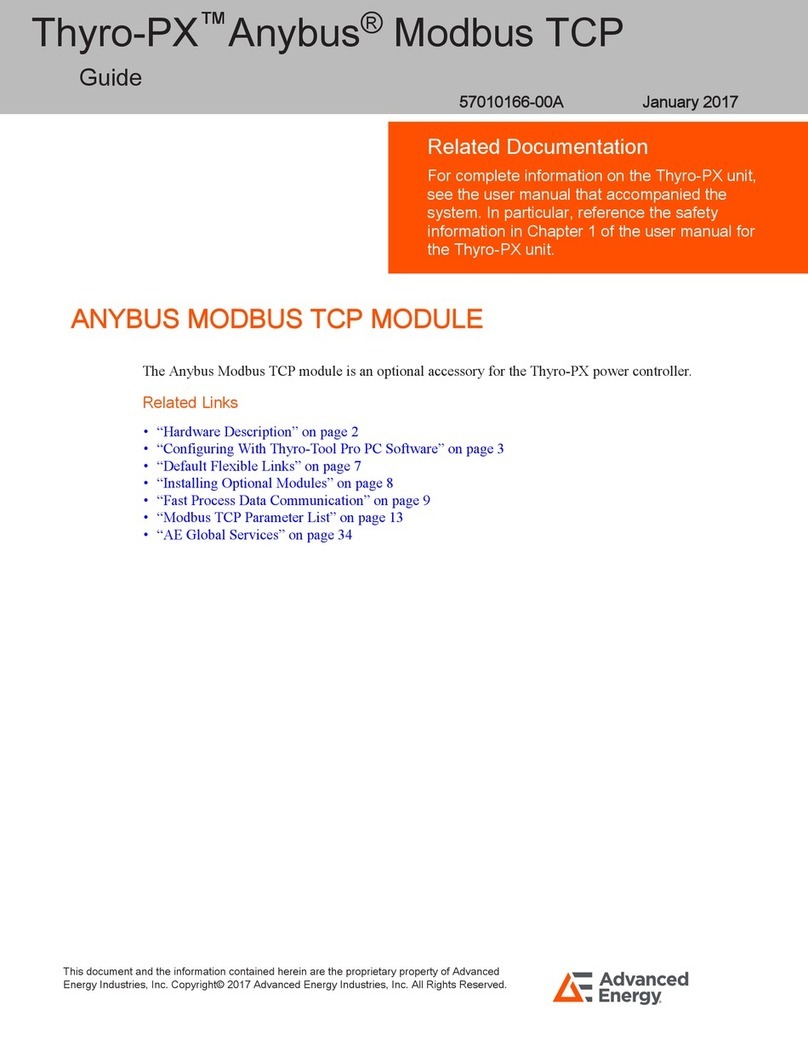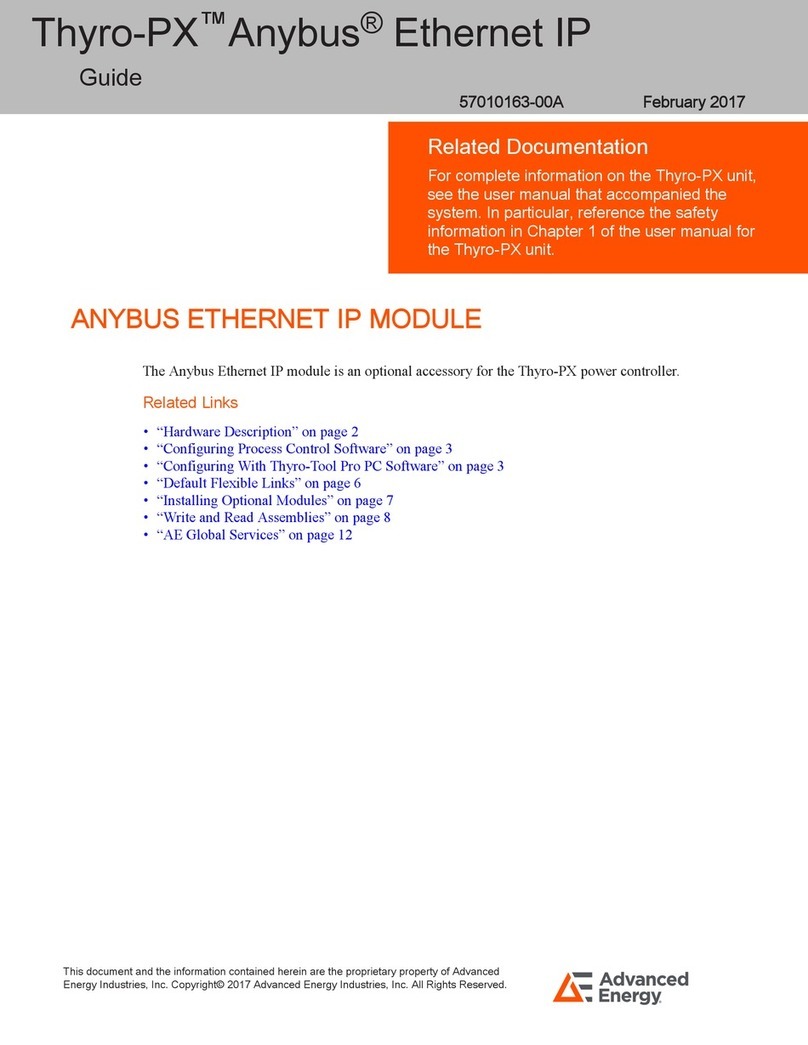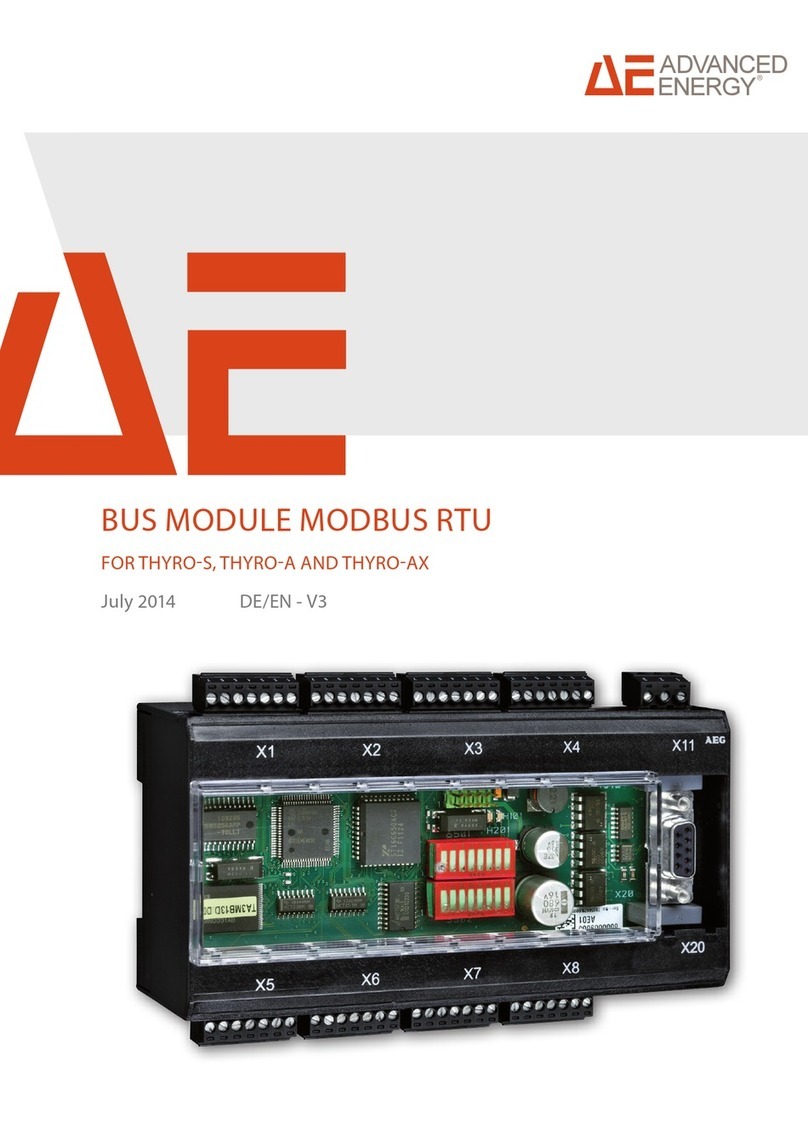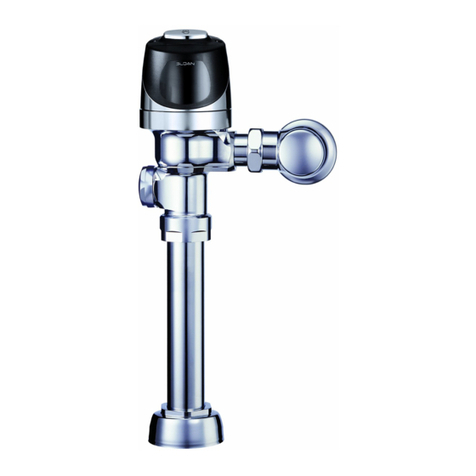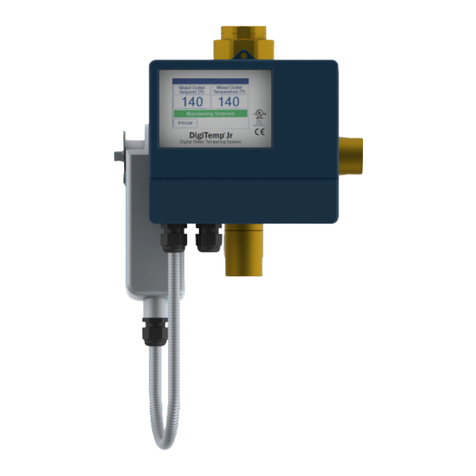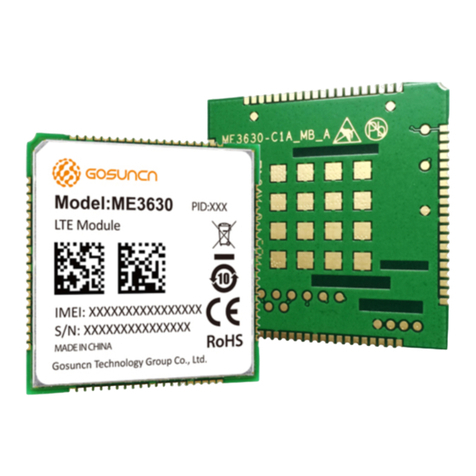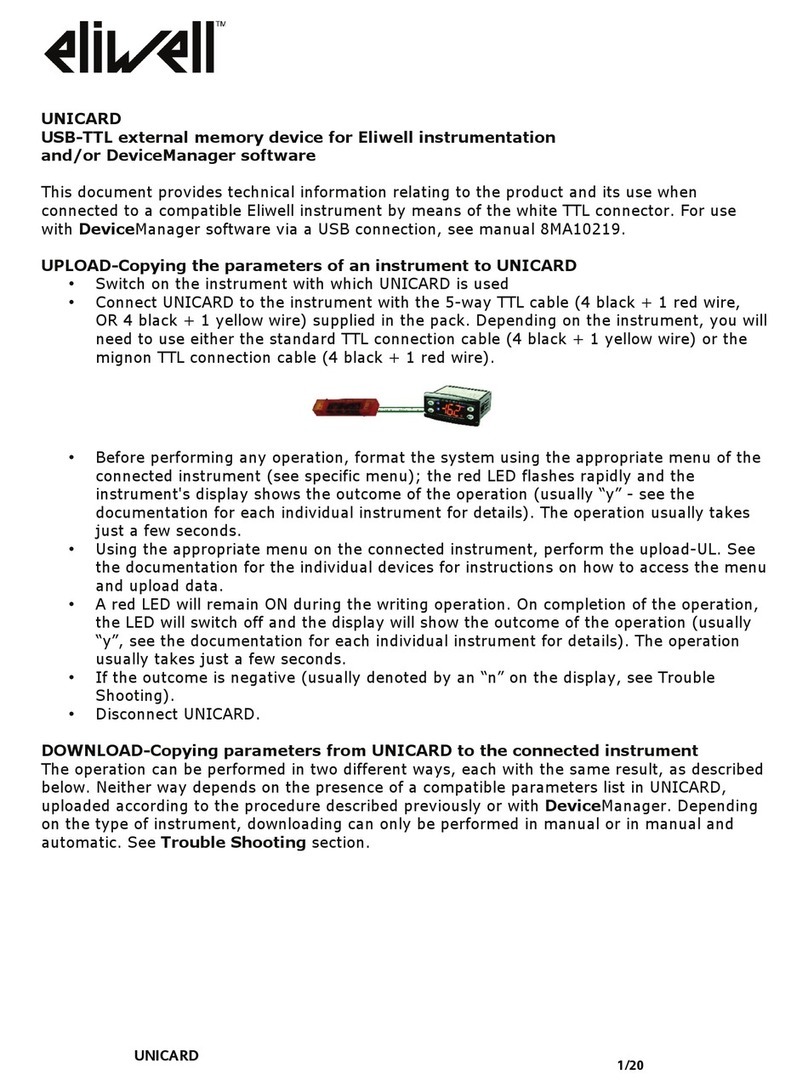Advanced Energy Thyro-Power Manager User manual


3
1.6. MANUFACTURER
AEG Power Solutions GmbH
Emil-Siepmann-Straße 32
D-59581 Warstein
1.7. CONTACT
TECHNICAL QUERIES
If you have any technical queries regarding the subjects dealt with in these operating
instructions, please get in touch with our team for power controllers:
Phone: +49 (0) 2902 763-520
COMMERCIAL QUERIES
If you have any commercial queries on power controllers, please get in touch with:
Phone: +49 (0) 2902 763-558
SERVICE-HOTLINE
Our team is at your service on the following hotline:
Phone: +49 (0) 2902 763-600
INTERNET
Further information about our company or products please visit:
http://www.aegps.com
1.8. COPYRIGHT
The forwarding, copying and/or receipt of this operations manual via electronic or
mechanical means, even in part, requires the expressive prior and written approval of AEG
PS.
© Copyright AEG Power Solutions GmbH 2012.
All rights reserved.
1.9. FURTHER INFORMATION ON COPYRIGHT
Thyro- is an international registered trademark of AEG Power Solutions GmbH.
All other company and product names are (registered) trademarks of the respective owners.
4
TABLE OF CONTENTS
1. NOTES TO THESE OPERATING INSTRUCTIONS...........................................................2
1.1. INFORMATION DUTY...................................................................................................2
1.2. VALIDITY.......................................................................................................................2
1.3. LOSS OF GUARANTEE................................................................................................2
1.4. HANDLING.....................................................................................................................2
1.5. CONFORMITY...............................................................................................................2
1.6. MANUFACTURER.........................................................................................................3
1.7. CONTACT......................................................................................................................3
1.8. COPYRIGHT..................................................................................................................3
1.9. FURTHER INFORMATION ON COPYRIGHT...............................................................3
2. GENERAL DESCRIPTION.................................................................................................7
3. INTENDED USE.................................................................................................................8
3.1. APPLICATION...............................................................................................................8
3.2. LIABILITY.......................................................................................................................8
3.3. DEPLOYED SYMBOLS.................................................................................................8
3.4. SAFETY INSTRUCTIONS.............................................................................................9
3.4.1. ACCIDENT PREVENTION REGULATIONS.............................................................9
3.4.2. GENERAL SAFETY NOTES...................................................................................10
3.4.3. FIRE PROTECTION................................................................................................11
3.4.4. QUALIFIED PERSONNEL......................................................................................11
3.4.5. SAFETY CONSCIENTIOUS WORK BEHAVIOR....................................................12
4. INSTALLATION ................................................................................................................12
4.1. SAFETY NOTES..........................................................................................................12
4.2. SCOPE OF DELIVERY, ASSEMBLY ..........................................................................13
4.2.1. SCOPE OF DELIVERY...........................................................................................13
4.2.2. ASSEMBLY.............................................................................................................13
4.3. STORAGE....................................................................................................................13
4.4. REQUIREMENTS FOR INSTALLATION.....................................................................13
4.4.1. DIMENSIONS / WEIGHTS......................................................................................13
4.4.2. GENERAL REQUIREMENTS.................................................................................14
4.5. INSTALLATION............................................................................................................14
4.5.1. COOLING................................................................................................................14
4.5.2. GROUNDING..........................................................................................................14
4.5.3. ELECTRO TERMINALS..........................................................................................14
4.5.4. CONNECTION DIAGRAMS....................................................................................16
4.5.4.1. CONNECTION FOR VOLTAGE SUPPLY..........................................................16
4.5.4.2. CONNECTION FOR NETWORK LOAD OPTIMIZATION / POWER
CONTROLLER..........................................................................................................................16
4.5.4.3. CONNECTION FOR NETWORK PEAK VALUE MONITORING /
MEASUREMENTS ....................................................................................................................17
4.5.4.4. CONNECTION FOR ANALOG OUTPUTS.........................................................19
4.5.4.5. CONNECTION FOR ERROR AND ALARMOUTPUT.......................................21
4.5.4.6. CONNECTION FOR DIGITAL OUTOUTS.........................................................21

5
4.5.4.7. CONNECTION FOR ANALOG DC INPUTS ......................................................22
4.5.4.8. CONNECTION OF ANALOG AC INPUTS.........................................................23
5. SHUT DOWN, DISASSEMBLY.........................................................................................24
5.1. SAFETY NOTES..........................................................................................................24
5.2. ELECTRO TERMINALS...............................................................................................24
5.3. SEPERATION..............................................................................................................25
6. FUNCTIONAL DESCRIPTION..........................................................................................25
6.1. GENERAL INFORMATION..........................................................................................25
6.2. MAINS LOAD OPTIMIZATION ....................................................................................25
6.2.1. AUTOMATIC STATIC MAINS LOAD OPTIMIZATION............................................28
6.2.2. MANUAL STATIC MAINS LOAD OPTIMIZATION..................................................28
6.2.3. REDUCTION OF CONVERTER TYPE PERFORMANCE VIA NETWORK LOAD
OPTIMIZATION.........................................................................................................................31
6.3. ADDITIONAL MEASUREMENT DEVICE....................................................................32
6.3.1. ZME FUNCTION.....................................................................................................32
6.3.2. MONITORING OF NETWORK PEAK LOAD..........................................................33
6.3.3. VOLTAGE MEASUREMENT ..................................................................................34
6.3.4. POWER AND ENERGY MEASUREMENT.............................................................34
6.3.5. TEMPERATURE MEASUREMENT........................................................................35
6.3.6. MEASUREMENT OF THREE ANALOG INPUTS...................................................35
6.3.7. MEASUREMENT OF THREE ANALOG INPUTS...................................................35
6.4. I/O MODULE (BUS/PC)...............................................................................................36
6.5. MESSAGES.................................................................................................................36
6.5.1. MESSAGES AT THE ERROR OUTPUT.................................................................36
6.5.2. MESSAGES AT THE ALARM OUTPUT.................................................................36
6.5.3. FURTHER MESSAGES..........................................................................................36
6.5.4. FUSE TRIGGERING...............................................................................................37
7. DISPLAY AND OPERATING ELEMENTS........................................................................37
7.1. SWITCH S1..................................................................................................................37
7.2. SWITCH S2 – QUANTITY ...........................................................................................38
7.3. SWITCH S3 – OPERATING MODE.............................................................................39
7.4. POTENTIOMETER R309.............................................................................................40
7.5. POTENTIOMETER R310.............................................................................................41
7.6. ANALOG OUTPUTS....................................................................................................42
7.7. LEDs............................................................................................................................43
7.8. PC PROGRAMM..........................................................................................................43
8. COMMISSIONING............................................................................................................44
8.1. PROCESS OF COMMISSIONING...............................................................................44
8.1.1. SETTING OF THE OPERATING MODE.................................................................44
8.1.2. SETTING THE NUMBER OF DEVICES DEPLOYED.............................................45
8.1.3. SETTING THE LIMITING VALUE FOR MONITORING..........................................45
8.1.4. SETTING THE ELEMENTARY PERIOD DURATION T0........................................45
9. OPERATION.....................................................................................................................45
9.1. REGULAR OPERATION..............................................................................................45
9.2. SERVICE OPERATION...............................................................................................46
6
9.3. END OF OPERATION .................................................................................................46
10. MAINTANANCE................................................................................................................46
10.1. REPAIRS.................................................................................................................46
11. TECHNICAL DATA...........................................................................................................46
11.1. APPROVAL AND CONFORMITY...........................................................................48

7
2. GENERAL DESCRIPTION
The Thyro-Power Manager possesses numerous functions. The unit can also be deployed
for peak load network monitoring next to its use for network optimization (as a substitute for
the previously deployed SYT9 module). The measuring functions register the effective
values of up to three electrical currents (or voltages), and deliver their effective values as
DC signals (as a substitute for three previously deployed ZME modules). In the course of
this, the integration-time feature is capable for adjustment so that measurements can be
made during full frequency operations. Power and energy consumption may also be
measured. Furthermore, the measurement of mains voltage, temperature, and three DC
inputs is performed. These values may also be displayed. A monitoring function is available
for the most of these measurement values. The unit possesses a serial interface for the
purpose of PC connection, and an interface to the bus modules of the Thyro-Family. Thus,
the capability is provided for the query of all measurement values via a PC or bus system.
Next to the easily performed adjustment capability via a switch or potentiometer, the Unit
can also be configured via a comfortable PC program (or via a bus). In the operations mode
“I/O Module”, the analog inputs and outputs, as well as the digital outputs, may be set or
read via a bus (or via a PC). Furthermore, an operations time counter is integrated into the
unit.
Basically the unit is composed of the following components:
Voltage supply 110V /230V
Automatic frquency recognition
Terminal to bus module (PROFIBUS)
10x Syt-type potential-free terminals
RS232-PC terminal
Error and alarm output
6x analog outputs for 0 – 10V
3x analog inputs, energy levels are selectable
3x converter inputs 1V~ / 100%
Potentiometers, switches, LEDs
Figure 1: Block diagram
8
The unit is designed for extreme easy operations. Thus, the number of connected power
controllers can directly be adjusted via the rotary switch S2, and the operating mode can
directly be adjusted via the rotary switch S3.
In its delivery status, operating mode 1 for “Automatic Static Network Distribution” is set to
be activated (rotary switch S3 = 1). In this application case, the user must then only set the
number of connected power controllers or power controller groups, respectively, via the
rotary switch S2. Further settings are not necessary.
The unit is designed for assembly to an overhead rail. The connection is implemented via
screw / plug terminals. Voltage supply may selected to either 230V~ or 110V~. The network
frequency is automatically recognized, and all according times are adapted.
3. INTENDED USE
3.1. APPLICATION
This unit has the purpose for the network load optimization of power controllers, for use as
measurement map for analog measurement values, and for use as bus I/O module. The unit
is permitted to be used only for these purposes.
Any other application is an abuse of use, and can endanger persons. Any liabilities of the
manufacturer become void upon abuse of use. The operator and the user of the unit shall
solely burden the risks for abuse of use.
Intended use includes the observation of the operations manual and compliance with
inspection and maintenance intervals. All malfunctions must be remedied immediately,
especially those that impact the safety of the unit.
3.2. LIABILITY
No liability is burdened for non-intended use of the unit. The operator and user shall burden
the responsibility for possibly necessary measures for the prevention of people and asset
damage. In case of complaints regarding the unit, please contact us immediately and
include the following information:
Type designation
Fabrication number
Complaint description
Duration in operation
Envirnmental conditions
Operation mode
3.3. DEPLOYED SYMBOLS
The following warning, prohibition, command, and notice symbols are used in the operations
manual, around and within the unit, and at the entrance to the switch room:

9
Symbol Description
Mains Voltage - Danger!
This warning note refers to an especially endangering
situation. Upon non- compliance, death or major injuries may
occur due to electric shock. Please adhere to the described
work and process procedures exactly, in order to avoid
damage to people or to the unit.
Danger!
This warning note refers to an especially endangering situation. Upon non-
compliance, death or major injuries are risked. Please adhere to the described
work and process procedures exactly, in order to avoid dama
g
e to people or to
the unit.
Caution!
This warning note refers to a possibly endangering situation. Upon non-
compliance, minor or medium-level injuries or damage may occur.
Warning about Electro-Magnet Field!
Electrical devices, clocks, magnetic storage cards etc. may malfunction or be
uncharged.
Hot Surfaces!
Danger of burning. Prevent touching or wear protection clothes.
Information, Note
Notes regarding technical requirements and additional information are
provided here, which the user shall observe.
3.4. SAFETY INSTRUCTIONS
3.4.1. ACCIDENT PREVENTION REGULATIONS
Please unconditionally observe the accident prevention regulations of the host country as
deployed within, and the generally valid safety instructions in accordance with IEC 364.
The following 5 safety rules must be complied with, prior to the beginning of all work
performed to the unit:
i
10
Attention Mains Voltage!
Safety rules for work performed to electrical facilities:
1. Disconnect equipment from the mains (establish a voltage free status)
2. Secure equipment against re-activation
3. Determine voltage free status of equipment by measurement
4. Ground and short-circuit equipment
5. Cover or establish borders to neighboring parts under voltage
3.4.2. GENERAL SAFETY NOTES
Important instructions stand out by the use of warning symbols, prohibition symbols,
command symbols, or notice symbols.
The unit is designed in accordance with state-of-art
technology and accepted technical safety rules.
In spite of this, dangers for the user or third parties and
impairments to the unit and other assets may unfold in
the course of its use.
Poor knowledge about operations and maintenance may
create damage to persons or assets.
Operations and maintenance within the set rule
boundaries, as well as compliance with the following
listed safety regulations, are necessary for the protection
of personnel and for the conservation of operational
readiness.
Personnel, who assemble, dis-assemble, start-up,
operate, and maintain the units, must know and observe
these safety regulations.
All work may only be performed by expert personnel
trained for the task assigned using those tools, fixtures,
inspection means, and materials for consumption as
designed for.
Please observe all legal or otherwise committing
regulations for accident prevention and environmental
protection.
Prior to task start-up, personnel assigned for tasks to the
Unit must have read the general and special safety
notes, and have sufficiently become acquainted with the
operations of the unit.

11
No changes, assemblies, and re-fittings, which impact the safety of the
Unit, are allowed to be performed to the Unit without approval of the
manufacturer.
Please secure that only personnel, who are accordingly assigned for
work on the unit, are deployed. Third parties shall be held away from
the unit, and also be pointed to the possible dangers.
Work performed to the unit may only be performed by an electronic
technician expert or by vocationally trained persons under the
management and peer-overview of an electronic technician expert in
accordance with technical electronic regulations.
The user must install the unit within a casing or switch cabinet so that
no dangers exist due to touching and that those applicable standards
and safety regulations are complied with.
For all maintenance and repair work, the unit must be completely de-
activated and secured against unintended re-activation in accordance
with the 5 safety rules (see chapter 3.4.1.).
Existing safety switches are not permitted to be by-passed, de-
activated, or be manipulated in any manner within any operational mode
of the unit whatsoever.
3.4.3. FIRE PROTECTION
Danger of fire!
In the case of smoke or smell development, as well as in case of fire,
the unit shall immediatel
y
be switched free of volta
g
e, and a report shall
be made to maintenance personnel. Smoking or open fire is forbidden.
3.4.4. QUALIFIED PERSONNEL
The unit may only be transported, be assembled, be connected, be
started up, be maintained, and be operated by expert staff members
who master the respectively valid safety and assembly regulations.
Safety regulations shall unconditionally be complied with!
All work performed shall be controlled by responsible expert personnel.
12
The duly responsible manager for Unit safety with regard to the necessary tasks envisioned
must authorize expert personnel. Expert personnel are those staff members, who:
Possess the vocational training and experience within the according work area,
Are knowledgeable about the respectively valid legal regulations (laws and codes),
standards, rules, instructions, and accident prevention rules,
Are vocationally trained as to the functional features and operational conditions of the
unit,
Recognize dangers, and are capable of implementing measures in order to prevent
dangers,
Regulations and definitions regarding expert personnel are contained within DIN EN 50110-
1:2004 (DIN EN 50110-1:2004 substitutes DIN 57105-1 and DIN VDE 0105 part 1).
3.4.5. SAFETY CONSCIENTIOUS WORK BEHAVIOR
Qualified personnel as defined in chapter 4.2.6 are responsible for safety. These personnel
are also responsible that only accordingly qualified persons are located at the unit or within
the safety area. Observe the following items:
Caution!
Refrain from an
y
kind of workin
g
behavior, which impacts the safet
y
of
persons and the function of the Unit in any form.
Operate the Unit only in a proper condition.
No safety fixtures are allowed to be dis-assembled or be put out of
function. Operationally contingent measures shall be implemented
prior to the removal of safety fixtures for the execution of maintenance
and service, or other work tasks.
Always work in compliance with the 5 technical electrical safety
regulations!
4. INSTALLATION
4.1. SAFETY NOTES
The following 5 safety rules must be complied with, prior to the beginning of all work
performed to the unit:

13
Attention Mains Voltage!
Safety rules for work performed to electrical facilities:
1. Disconnect equipment from the mains (establish a voltage free status)
2. Secure equipment against re-activation
3. Determine voltage free status of equipment by measurement
4. Ground and short-circuit equipment
5. Cover or establish borders to neighboring parts under voltage
4.2. SCOPE OF DELIVERY, ASSEMBLY
4.2.1. SCOPE OF DELIVERY
The delivery is comprised of the following parts:
Thyro-Power Manager
Pouch with screws/ plug terminals
Operating instructions
4.2.2. ASSEMBLY
The units must be assembled on the overhead rail within a switch cabinet / casing.
Voltage supply is performed at terminal X1. In the course, the connection voltage must
be selected there, and the according jumpers must be set (230V~ jumper X1.5 – X1.6;
110V~ jumper X1.4 –X1.6 and jumper X1.5 – X1.7).
Grounding shall be performed at X1.1 or X1.2 in accordance with local regulations! For
this, see also chapter 4.5.4.1 connection for voltage supply.
4.3. STORAGE
The Unit may be stored in rooms, which are dry, ventilated, and equipped with a fixed
protection roof, and originally packaged.
Permissible ambient temperature: -25°C to +55°C
Permissible relative air humidity: max. 85%
For longer storage durations, the Units should be contained in airtight plastic skins with the
use of commercially available drying agents.
4.4. REQUIREMENTS FOR INSTALLATION
4.4.1. DIMENSIONS / WEIGHTS
The Unit possesses the following dimensions and weight:
14
Unit Width Height Depth Weight
Thyro-Power
Manager 150mm 95mm 60mm 0.35kg
Consider the following necessary free space upon assembly:
20 mm upwards
20 mm downwards
4.4.2. GENERAL REQUIREMENTS
The units may be assembled next to each other without a sideward gap.
The user must install the Unit within a casing or switch cabinet so that no dangers exist due
to touching and that those applicable standards and safety regulations are complied with!
4.5. INSTALLATION
4.5.1. COOLING
It shall be observed that the maximum ambient temperature of 55°C is not exceeded.
4.5.2. GROUNDING
Grounding shall be performed in accordance with the local regulations (terminal X1.1 / X
1.2)! Grounding is also achieved via EMC facilities (Y – capacitor 4.7nF).
4.5.3. ELECTRO TERMINALS
The unit shall only be connected to the voltage supply, and to further external components
(power controllers, measuring transformers), which are contingent to the application. For
this, the following connections are necessary:
Voltage supply: 110V~ / 230V~ at terminal X1
Mains load optimization: power controller at terminals X3, X4
Network peak load monitoring / measurements:
o up to 3 converters (1V~) at terminal X5
o up to 6 DC outputs (10V-) at terminals X7, X8
o Error / alarm message at terminal X8
I/O mdoule:
oup to 10 digital outputs at terminals X3, X4
oup to 6 analog outputs (10V-) at terminals X7, X8
oup to 3 analog DC-inputs at terminals X5, X6
oup to 3 analog AC-inputs at terminal X5
PC-connection: at terminal X9 (RS232)
Bus module interface connection: at terminal X2

15
As different applications can also be deployed simultaneously, it is necessary to connect the
most various of terminals, in part. E.g., network load optimization (connection of the power
controllers to X3 and X4) and simultaneously network peak-load monitoring (connection of
three electrical current converters to X5) could be deployed, as well as electrical current
measurement (connection of three measurement instruments to X7), and the output of three
analog values (connection of further equipment to X7 and X8). Additionally, three further
analog inputs could be used for reading, and be evaluated via a bus (connection of analog
inputs to X5 and X6, and a bus module connection to X2).
An overview of connection opportunities is displayed in the following
figure:
Figure 3: Connection overview
16
4.5.4. CONNECTION DIAGRAMS
As different connections may be necessary as contingent to the application, the connection
diagrams are illustrated in groups.
4.5.4.1. CONNECTION FOR VOLTAGE SUPPLY
Figure 4: Connection diagram for voltage supply 230V~; 50/60 Hz
Figure 5: Connection diagram for voltage supply 110V~; 50/60 Hz
4.5.4.2. CONNECTION FOR NETWORK LOAD OPTIMIZATION / POWER
CONTROLLER
The unit possesses 10 digital outputs at the terminals X3 and X4, in total. These are
designed as potential-free optical coupler outputs. They are deployed as synchronization
outputs (SYT) for the connected power controllers or power controllers groups during the
network load optimization process. Up to 10 Power Controllers can be connected per

17
channel. To operate a 2-wire shielded cable is required between Thyro-Power Manager and
each power controller.
Figure 6: Connection diagram for main load optimization using Thyro-A
Figure 7: Connection diagram for main load optimization using Thyro-P
4.5.4.3. CONNECTION FOR NETWORK PEAK VALUE MONITORING /
MEASUREMENTS
External electrical current converters including load resistances are necessary for
network peak-value monitoring and current measurement. Such must be designed so
that a measurement voltage of 1V~ unfolds as operating at a nominal electrical current
(voltage at the load resistance). These converters must be assembled into the network
supply of the facility for the purpose of network peak-value monitoring. The converter
18
type (for electrical current or for voltage), as well as their nominal values, should be
configured using a PC program!
Figure 8: Connection diagram for network peak load monitoring / Electrical current
measurement
An external electrical current converter (input 1) and an external voltage converter (input 2)
are needed for (single-phase) power and energy measurement. Input 3 may further be
deployed, additionally. Again, both converters must be configured in a manner so that a
1V~ measurement voltage is generated at a nominal electrical current and at a nominal
voltage. For this reason, the electrical current converter must be equipped with an
adequate load resistance, and possibly, an adequate series resistance must deploy
together with the voltage converter. The internal resistance of the measurement device is
7540 Ohms.

19
Figure 9: Connection diagram for power and energy measurement
An AEG voltage converter (order no. 2 000 000 399) can be deployed as voltage
transformer. This device possesses a transformer ratio of 16:1, and can primarily be used up
to 690V. If this converter is deployed, the following series resistance values result:
Series resistance
[Ohm]:
Mains
voltage
[V]:
Secondar
y
voltage. [V] Calculate
d
: Selected: Note:
110
0
6,875
5
44298 44000
22k + 22k
230
0
14,375
5
100848 101000
100k + 1k
400
0
2
5
180961 181000
180k + 1k
500
0
31,25
5
228087 228200
220k + 8k2
690
0
43,125
5
317625 320000
220k + 100k
Table 3: Series resistance values for AEG voltage converter
4.5.4.4. CONNECTION FOR ANALOG OUTPUTS
All measurement values may be read from one (or more) of the six analog outputs (0 –
10V).
20
Standard setting:
Output no.: Terminals Standard output:
1 X7.1 / X7.2 Converter 1
2 X7.3 / X7.4 Converter 2
3 X7.5 / X7.6 Converter 3
4 X7.7 / X7.8 Mains voltage
5 X7.9 / X7.10 Temperature
6 X8.1 / X8.2 Bus value 6 / adjustment
support
Table 4: Standard output values for analog outputs
Figure 10: Connection diagram for analog outputs

21
4.5.4.5. CONNECTION FOR ERROR AND ALARM OUTPUT
The unit possesses an error and alarm output at the terminal X8. These are designed as
potential-free optical coupler outputs.
Figure 11: Connection diagram for the error and alarm output
The positive potential of voltage (e.g. +24V) has to be connected to terminals X8.6 and
X8.4. This voltage will than eventually be released at terminal X8.5 (Alarm) and X8.3 (Error)
and for example can be transmitted to the input of a SPS.
4.5.4.6. CONNECTION FOR DIGITAL OUTOUTS
If the unit is not deployed for network load optimization, but as I/O module, the 10 SYT
outputs at the terminals X3 and X4 may be used as digital outputs. These are designed as
potential-free optical coupler outputs.
22
Figure 12: Connection diagram for digital outputs
4.5.4.7. CONNECTION FOR ANALOG DC INPUTS
The Unit possesses 2 analog DC inputs, whose input values can be dip-switch selected.
Three range intervals can be selected by the help of the dip-switches S1.1 to S1.4.
Input 1 Input 2
Interval
range S1.2 S1.1 S1.4 S1.3 Ri
0-10V Off Off Off Off 88 kOhm
0-5V On Off On Off 44 kOhm
0-20mA On On On On 250 Ohm
Table 5: Range interval selection for the connection of analog DC inputs
The third analog input does not possess this selection opportunity; it has a fixed input
voltage range of 0 – 10V.

23
Figure 13: Connection diagram for analog DC inputs
Note:
The initial value of the analog inputs can be increased to 4mA (and 1V or 2V, respectively)
by deploying the dip-switch S1.7.
This is necessary if e.g. a range interval of 4- 20mA is desired.
4.5.4.8. CONNECTION OF ANALOG AC INPUTS
If the unit is not deployed for network peak-load monitoring, but as I/O module, the 3
transformer inputs at the terminal X5 may be used as analog AC inputs. The measurement
range interval is 0 – 1V~.
24
Figure 14: Connection diagram of analog AC inputs
5. SHUT DOWN, DISASSEMBLY
Shutdown and disassembly of the unit may be performed for the reason of venue change or
for disposal purposes.
5.1. SAFETY NOTES
The following 5 safety rules must be complied with, prior to the beginning of all work performed
to the unit:
Attention Mains Voltage!
Safety rules for work performed to electrical facilities:
1. Disconnect equipment from the mains (establish a voltage free status)
2. Secure equipment against re-activation
3. Determine voltage free status of equipment by measurement
4. Ground and short-circuit equipment
5. Cover or establish borders to neighboring parts under voltage
5.2. ELECTRO TERMINALS
For disassembly, perform the following steps:
1. Separate the Unit from the voltage supply 230V~, respectively 110V~.
2. Separate all other connections.
Electrical connections are thus disassembled

25
5.3. SEPERATION
Now, the Unit can be completely removed by dis-assembly from the overhead rail.
6. FUNCTIONAL DESCRIPTION
6.1. GENERAL INFORMATION
Basically, the Unit possesses the following functions:
Network load optimization
Network peak load Monitoring
Measurement capability
I/O module
These shall be described in detail as follows.
6.2. MAINS LOAD OPTIMIZATION
If the power controllers operate according to the principle of full frequency package control
(TAKT), this can lead to increased network load due to an unfavorable distribution of ON
and OFF switching times. This then results into negative impacts, such as a higher power
loss, and flicker effects etc.
If load elements are deployed, whose resistance increases in the course of time (ageing),
even a converter with enhanced design performance must possibly be implemented (for
this, see chapter 6.2.3).
All of these negative effects may be avoided and be reduced to minimum measure by use of
the Thyro-Power Manager. The following figure displays the worst case, in which all power
controllers activate and de- activate at the same time:
26
Figure 16: Current distribution in worst case
As one may notice, a 10-fold electrical current flow results simultaneously (in case of 10
power controllers having the same load), whereas no electrical current flows during the
other times.
If the elementary period duration T0 = 1s or 50 network periods, respectively, the effective
electrical current computes as follows:
If one assumes the electrical current of an power controller to be I0 = 1, the start-up time to
be Ts = 3, and the elementary period duration to be T0 = 50, the following may be
computed:

27
If the Thyro Power Manager is deployed in replacement, each power controller is switched
into series operations. This is displayed in the following figure:
Figure 17: Current distribution with mit Thyro-Power Manager
The maximum electrical current value is thus now that of a single power controller, and the
start-up time Ts is now 10 * 3 = 30 periods. Thus, the formula may be derived to be:
28
If one again assumes the electrical current of a power controller to be I0 = 1, the start-up
time to be Ts = 3 and the elementary period duration to be T0 = 50, the following may be
computed:
In a worst case, the effective value for the electrical current would be 3.18 times higher as
compared to network load optimization using the Thyro-Power Manager.
6.2.1. AUTOMATIC STATIC MAINS LOAD OPTIMIZATION
In operations mode 1, the set elementary period duration T0 (Poti R309) is evenly
distributed onto the number of power controllers (S2).
The start-up time point of each controller is shifted by 5 periods (100ms) in each single
case, as the situation displayed above for e.g. T0 = 50 periods (1s) and 10 power
controllers.
Thus, it results in a more even distribution of electrical power current.
Even groups of power controllers may be connected to an output instead of a single power
controller (see also chapter 4.5.4.2 on page 9). In the course, each controller / group should
provide equal power and carry equal load.
Start-up times of
the power controller
based on network periods
Figure 18: Automatic time allocation
6.2.2. MANUAL STATIC MAINS LOAD OPTIMIZATION
In operations mode 2, the elementary period duration T0 (Poti R309) can be set manually
and in various manners contingent to the number of power controllers (S2). Yet, a
respective PC program or a bus connection is necessary for this. This type of manual
optimization makes sense if each single power controller accommodates strongly differing
target values, or if strongly differing loadings per power controller is deployed, whereby the
working point remains relatively stable, meaning the target values are held relatively

29
constant. In order to be able to perform optimization, the start-up times Ts of each single
power controller and their load I0 should be known (Thyro-Tool Family). The following
figures display an example deploying 6 power controllers:
Figure 19: Power controller without mains load optimization with different Ts
The following Ts selections are provided here:
Ts1 = 40, Ts2 = 10, Ts3 = 26, Ts4 = 13, Ts5 = 12, Ts6 = 10, accordingly as network periods
As the amount of electrical current I0 is equally high, one can optimize the start-up times as
follows:
T1 = 0 (from 0 – 39 ON), T2 = 40 (from 40 – 49 ON), thus 1 x 50 periods are fully
accommodated,
30
T3 = 0 (from 0 – 24 ON), T4 = 25 (from 25 – 37 ON), T5= 38 (from 38 – 49 ON, thus 2 * 50
periods are fully accommodated,
T6 = 0 (from 0 – 9 ON), the time point is not capable for optimization.
Thus, the electrical current distribution changes as follows:
Figure 20: Power controller with manual mains load optimization employing different Ts

31
The adjustment of the start-up times is performed via a PC program as follows::
Figure 21: manual time allocation
6.2.3. REDUCTION OF CONVERTER TYPE PERFORMANCE VIA NETWORK
LOAD OPTIMIZATION
f strongly-changing load resistance and heating elements are deployed, e.g. with a large
Rwarm/Rcold or Rold/Rnew ratio, and a group of power controllers are deployed to an input
transformer under the use of the zero cross principle, the implementation of the Thyro-
Power Manager can reduce and optimize the type performance of this transformer.
The circuit diagram is displayed in the following figure:
Figure 22: Input transformer and mains load optimization
Requirement: PLoad = P1 = P2 = Pn-1 = Pn = constant
If the power controllers (controllers) operate with a subordinately embedded power
controlling, the maximum transformer type power can roughly be computed as follows,
assuming they operate with phase-angle firing (VAR) and full frequency package control
(TAKT) at equally set start-up times Ts:
32
Under the deployment of full frequency package control (TAKT), network load optimization
enables time cascading of the start-up time Ts for each single power controller with the help
of the Thyro Power Manager. The transformer type power is then determined using:
Conditions:
The facility must be designed (configuration of the voltage and the load resistance) so that
the cycle ratio Ts/T0 almost achieves the value 1 upon attaining the maximum load
resistance value Rmax (e.g. due to ageing at the end of the life cycle or due to achieving
operational temperature).
6.3. ADDITIONAL MEASUREMENT DEVICE
The Thyro-Power Manager can also be deployed as additional measurement device (ZME).
In the course, the Thyro Power Manager substitutes the ZME cards as used up to now. If
electrical currents are measured using common measurement instruments upon deployment
of full frequency package control (TAKT), a significantly fuzzy display results. This does not
occur if using the Thyro-Power Manager.
The Thyro-Power Manager possesses three AC measurement inputs, which are designed
for the connection of electrical current or voltage converters (see also chapter 4.5.4.3 page
9 for more). Principally, alternating voltages ranging from 0 – 1V~ may be measured using
these three inputs (see also chapter 4.5.4.8 page 9 for more). The time measurement
interval and the integration time for measurement can be adjusted (standard value = T0 =
1s, Poti R309).
6.3.1. ZME FUNCTION
If electrical current or voltage converters are connected to the measurement inputs, the
effective value is measured (throughout the integration time interval), and furthermore
outputted as DC signal (0 – 10V) to the three analog outputs (see also chapter 4.5.4.4).
Additionally, the measurement values are also internally available, and may be queried via a
PC or bus system.

33
For electrical current converters, the load resistance must also be connected externally, and
the voltage converters must be configured accordingly (see also chapter 4.5.4.8 for this).
Generally, the output value can be freely adjusted at each of the six analog outputs; for
standard settings the measurement value 1 is read out to output 1, the measurement value
2 is read out to output 2, and the measurement value 3 is read out to output 3. A change of
standard settings can only be performed via a PC program or via a bus system (see also
chapter 4.5.4.4 for this). The following figure displays the principle structure and the
connection diagram upon use of the ZME function.
Strom Strom Strom
L1 L2 L3
Figure 23: Connection diagram for ZME function
6.3.2. MONITORING OF NETWORK PEAK LOAD
For the monitoring of network peak-load, the connecting process of the electrical current
converters is performed in the same manner as with the ZME function (see above). For this,
the three current converters should be located within the supply facility of the monitoring
unit.
34
The under-stepping of the set electrical current limiting value is the focus of monitoring and
subsequent reporting. Without deployment of a PC mode, the limiting value is equal for all
three measurement values, and can be set via the Poti R310 (standard setting = 200%).
With deployment of a PC mode, a different limiting value can be set for each of the three
measurement values via the help of a PC program or of a bus system.
If the limiting value is over-stepped, a message occurs at the alarm output (standard
setting), as well as via PC program and via bus system. The message remains as long as
the limiting value is over-stepped, if the value again falls below the limiting value, the
message is also automatically reset.
If the measurement integration time is set to T0 (standard setting for T0 = 1s), the
measurement process is terminated for each T0, and a comparison is then performed. Thus
within the standard setting, the shortest time for a message = 1s, and the shortest time for a
message duration is 1s. Instead of T0, also 1 network period can be set via a PC program or
bus system. This would possibly result in fuzzy displays, yet a message could then be
performed already after 20 ms (at 50Hz).
6.3.3. VOLTAGE MEASUREMENT
If voltage converters are deployed instead of electrical current converters, also voltages can
be measured (see also chapter 4.5.4.3 page 9 for this). Voltage converters must then be
designed so that a nominal voltage of 1V~ results on the secondary side. The internal
resistance of the measurement inputs is 7540 Ohms; this information can also be utilized for
voltage converters using an accordingly computed series resistance. The converter type and
the converter sizes may be set via a PC program and bus system.
6.3.4. POWER AND ENERGY MEASUREMENT
If one electrical current converter is connected to measurement input 1, and a voltage
converter is connected to measurement input 2, and both are correctly configured via a PC
program and bus system, one may also execute a (single-phase) power and energy
measurement (see also chapter 4.5.4.3). The reset of the energy counter and also of the
operating time counter is possible via a PC program. Furthermore, the third measurement
input can also be used in a random manner.
The following figure displays the actual value window box of the PC program for power and
energy measurements.

35
Figure 24: Actual value window box of the PC program for power and energy measurements
6.3.5. TEMPERATURE MEASUREMENT
The Thyro-Power Manager possesses a temperature sensor, e.g. the temperature inside the
switch cabinet can be measured and monitored with its help. The temperature value can be
read via a PC program or bus system. Within the standard settings, it is also read out at
analog output 5 (X7.9 / X7.10), whereby 10V = 100°C. Only temperatures > 0°C are read
out. A monitoring limiting value can also be set, if this limiting temperature is over-stepped
(or under-stepped, it is capable for setting), a message occurs at the error output via a PC
program and via a bus system.
6.3.6. MEASUREMENT OF THREE ANALOG INPUTS
The Thyro-Power Manager also measures the mains voltage or supply voltage, respectively.
This measurement can be read via a PC program or bus system. Within the standard
settings, it is also read out at analog output 4 (X7.7 / X7.8), whereby 10V = 230V.
6.3.7. MEASUREMENT OF THREE ANALOG INPUTS
The Thyro Power Manager also measures the values of three analog inputs (see also
chapter 4.5.4.7, page 9 for this). Input ranges can be selected between 0 – 5V, 0 – 10V, 0 –
20mA for two input terminals. The third input terminal possesses a fixed range of 0 – 10V.
Upon demand, the starting default value 0 can be changed to 4mA, 1V, and 2V (an offset
value and live zero). All input terminals can be read via a PC program or bus system.
36
6.4. I/O MODULE (BUS/PC)
The Thyro-Power Manager can also be used as I/O module for a bus system and from a
PC. In this operational mode, 10 SYT potential-free outputs are used as digital outputs for
network load optimization. They may be set or deleted from a bus or PC. The values of the
analog outputs (AC and DC), as well as the mains voltage and temperature may
(furthermore) be read out via a bus or PC. The values of the six analog outputs may then be
read out from the bus or PC, so that a voltage range of 0 – 10 V may be created for 6 cases
(configure the output to default “bus value”).
If the Thyro-Tool Family is installed on a PC, the communication server program is thus also
installed, from which the communication between PC and Thyro Power Manager is
executed. Via the help of this server program, it is also possible to simply implement the
communication from other programs, thus to enable the query and setting of values from the
Thyro-Power Manager (Excel, LabView, Visual Basic, C++ etc.) See also the examples
contained on the Thyro-Tool Family CD.
6.5. MESSAGES
In general, messages are performed via LED, error and alarm output, PC program, or via
the bus system. It can be adjusted via the PC program if a message should be read out via
the error or alarm output.
6.5.1. MESSAGES AT THE ERROR OUTPUT
Within standard default settings, the following messages are read out at the error output:
Mains frequency outside of 47 – 63 Hz
Error temperature monitoring
Invalid parameters
Undervoltage within the network
Overvoltage within the network
The error output can also be configured individually via a PC program or bus system.
6.5.2. MESSAGES AT THE ALARM OUTPUT
Within standard default settings, the following messages are read out at the alarm output:
Measurement value monitoring of converter 1
Measurement value monitoring of converter 2
Measurement value monitoring of converter 3
The alarm output can also be configured individually via a PC program or bus system.
6.5.3. FURTHER MESSAGES
An LED is also installed at each of the 10 SYT outputs for the purpose of network load
optimization, from which one can recognize if the output is set or not.

37
6.5.4. FUSE TRIGGERING
The Thyro-Power Manager possesses an internally built-in fuse (T 1A 250V). Yet, this only
serves the purpose for the internal protection of electronics and is not for power line
security. If this fuse responds, the green power LED H100 goes out, and the Unit does not
operate any more.
7. DISPLAY AND OPERATING ELEMENTS
The Thyro-Power Manager possesses three switches and two potentiometers, from which
all basic functions can be adjusted. Significantly more parameters / functions can be set by
help of the PC program and via the bus system.
7.1. SWITCH S1
Switch S1 is a simple 8-fold dip-switch. Each of the 8 dip-switches can be activated or
deactivated. If the according dip-switch is pushed to the right (label „open“), then it is open;
in contrast, if it pushed to the left, it is then closed. The following figures display the
according dip-switch position:
Dip switch open: Dip switch closed:
Figure 25: Dip switch position of S1
The following table displays the function of each dip-switch:
Dip switch function open closed default
S 1.8 PC mode OFF ON open
S 1.7 Live-Zero
(4mA) Without With open
S 1.6 Test mode OFF ON open
S 1.5 Without
function/
reserve
OFF ON open
S 1.4 Level input 2:
5V, 10V, 20mA Combination Combination closed
S 1.3 Level input 2:
5V, 10V, 20mA Combination Combination closed
S 1.2 Level input 1: Combination Combination closed
38
5V, 10V, 20mA
S 1.1 Level input 1:
5V, 10V, 20mA Combination Combination closed
Table 9: Switch S1
The input ranges for the input terminals 1 and 2 can be set as follows:
Input 1 Input 2
Range: S 1.2 S 1.1 S 1.4 S 1.3 Ri
0-10V Off Off Off Off 88 kOhm
0-5V On Off On Off 44 kOhm
0-20mA On On On On 250 kOhm
Table 10: Input range for the input terminals 1 and 2
7.2. SWITCH S2 – QUANTITY
For network load optimization, the number of connected power controllers or power
controller groups can directly be set via the help of the rotary switch S2. The following table
displays the adjustment possibilities:
Switch position Number of power
controllers
0 Not permitted
1 1
2 2
3 3
4 4
5 5
6 6
7 7
8 8
9 9
A 10
B Not permitted
C Not permitted
D Not permitted
E Not permitted
F Not permitted
Table 11: Switch position S2

39
S2 = number S3 = function
Figure 26: Switch S2 and S3
7.3. SWITCH S3 – OPERATING MODE
The desired function or operating mode can directly be set via the help of the rotary switch
S3. The following table displays the adjustment possibilities:
Switch position Operating mode
0 Not permitted
1 Automatic static network load optimization
2 Manual static mains load optimization*1
3 Reserve
4 Reserve
5 Reserve
6 Reserve
7 Reserve
8 Reserve
9 Reserve
A Reserve
B Reserve
C Reserve
D I/O module*1
E Reserve
F Reserve
*1additionally S1.8 = PC mode must be activated
Table 12: Switch position S3
40
7.4. POTENTIOMETER R309
If the Thyro Power Manager is configured without a PC program and bus system (S1.8
OFF), the elementary period duration T0 can thus be set via Poti R309. Yet, the standard
default setting is already set to 50 network periods (1s / 50Hz), and usually does not need
to be changed. If network load optimization is deployed, the set T0 must resemble the
elementary period duration of the deployed power controllers exactly. The standard default
settings of Thyro A and Thyro P are also 50 network periods (1s / 50Hz).
At the same time, the set T0 is also used as measurement integration time for the ZME
function (standard setting). If another measurement integration time is desired, such can
be set via a PC program, e.g. directly to one network period (20ms / 50Hz). Other values
may be set via a change of R309. As the potentiometer does not possess a scale, one can
deploy analog output 6 (X8.1 / X8.2) as help for the setting (connect the voltmeter, range 0
– 10V). If the potentiometer is changed, (no PC mode) the analog output is automatically
switched over to the output of the potentiometer value.
The setting range of R309 is relatively large, and extends from 1 – 1500 network periods.
For this reason, the setting help is divided into two intervals:
Interval 1: 0 - 100 periods
0 - 5V, meaning 5V = 100 periods, 2.5V = 50 periods, 1 period = 0.05V
Interval 2: 101 - 1500 periods
5 - 10V, meaning 5V = 100 periods, 10V = 1500 periods, 1 period = 0.00357V
(+5V)
The following figure and the table display the respective values:
Figure 27: Characteristic curve of the setting help R309
Table of contents
Other Advanced Energy Control Unit manuals
Popular Control Unit manuals by other brands
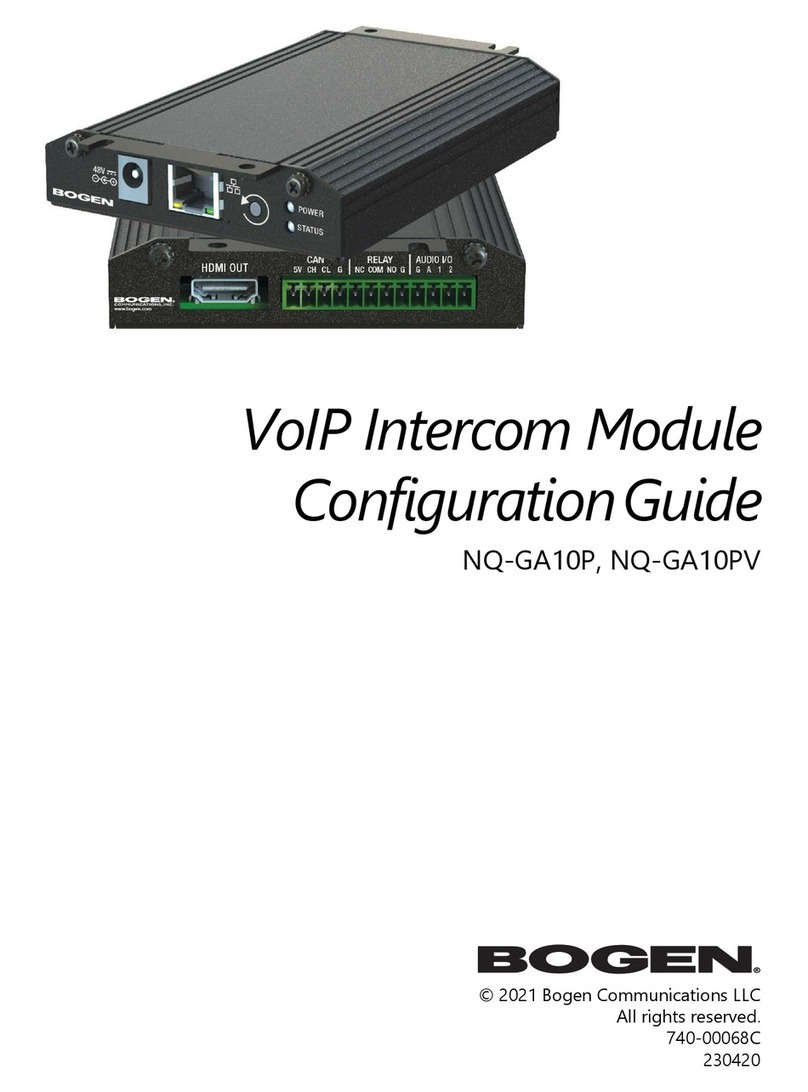
Bogen
Bogen NYQUIST NQ-GA10P Configuration guide
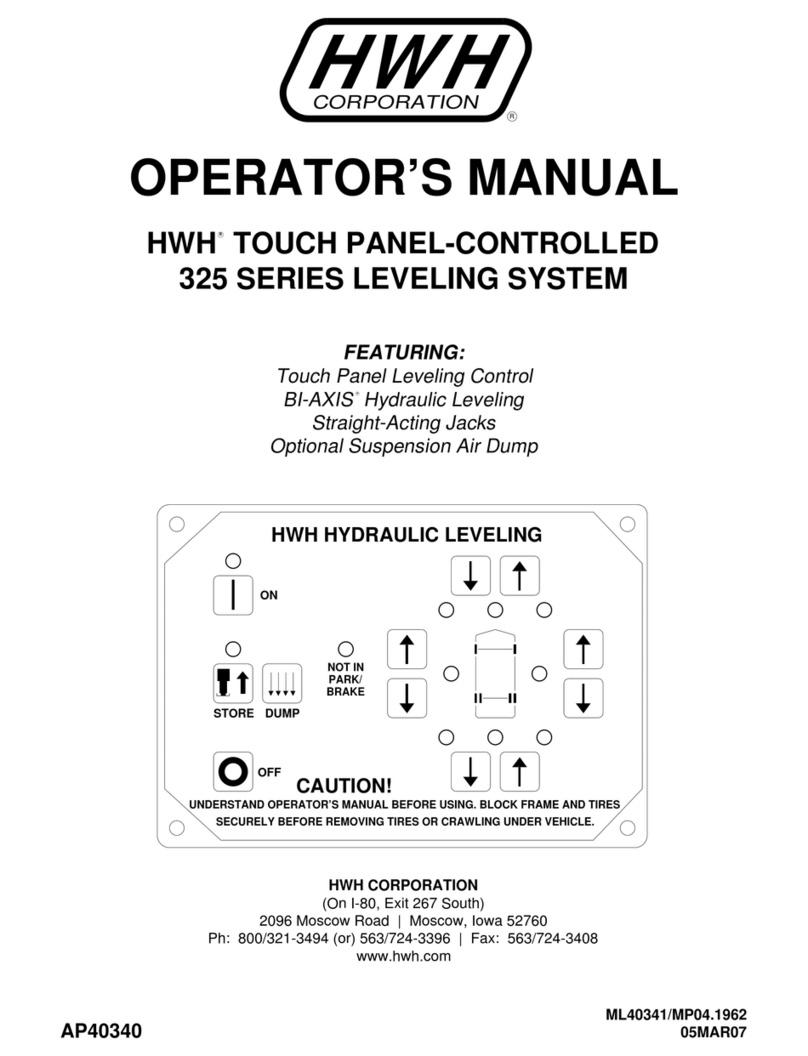
HWH
HWH 325 SERIES Operator's manual
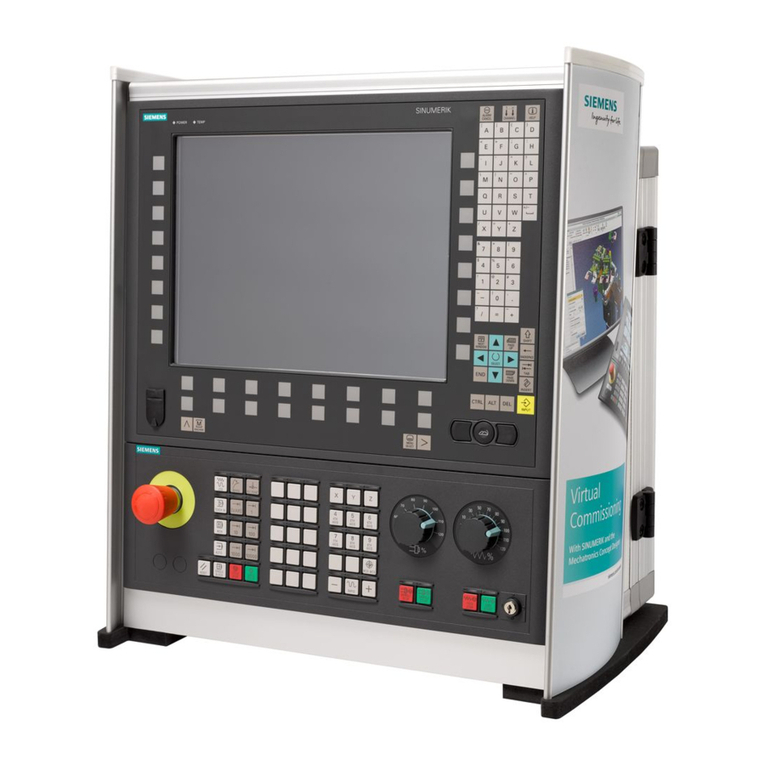
Siemens
Siemens SINUMERIK 840D sl Commissioning manual
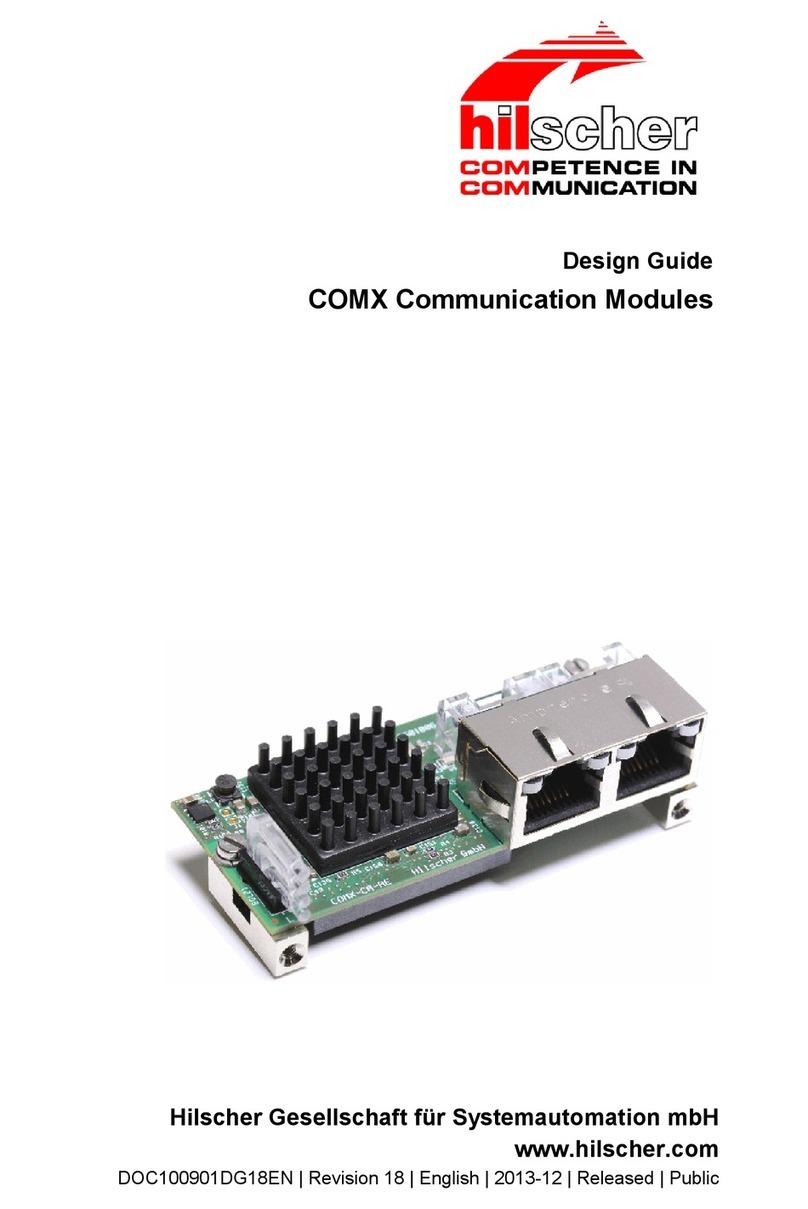
hilscher
hilscher COMX Series Design guide

Watts
Watts LFM113-12 Installation, operation and maintenance
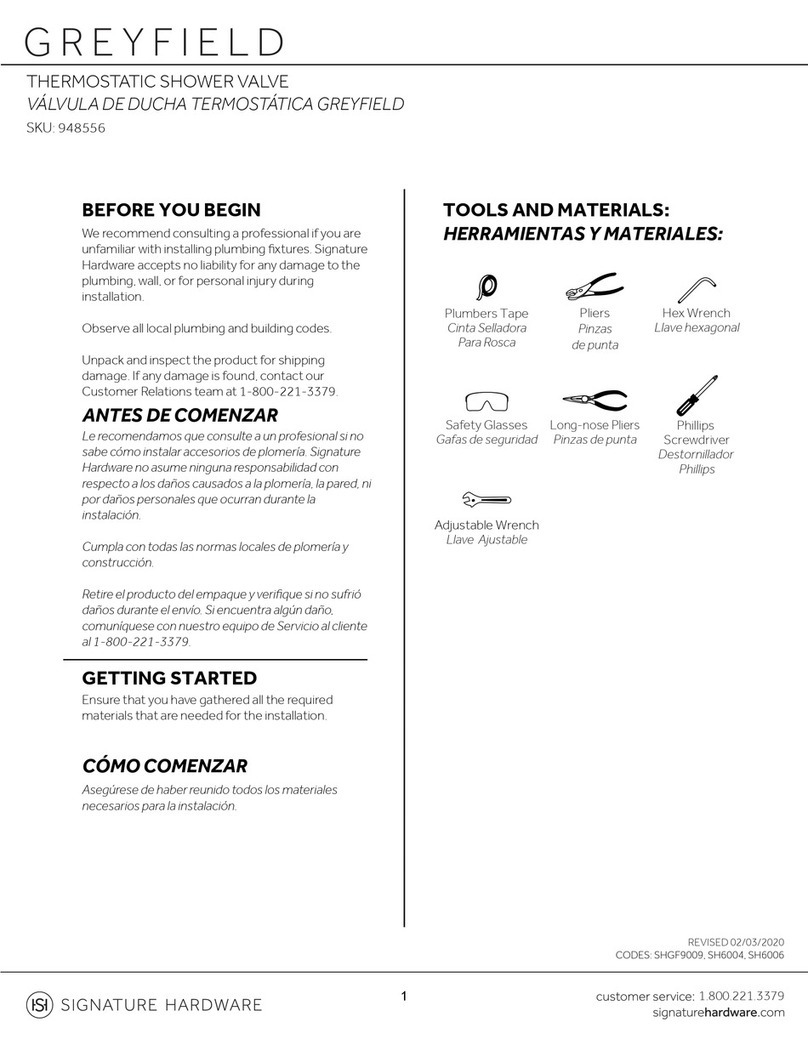
Signature Hardware
Signature Hardware GREYFIELD 948556 quick start guide
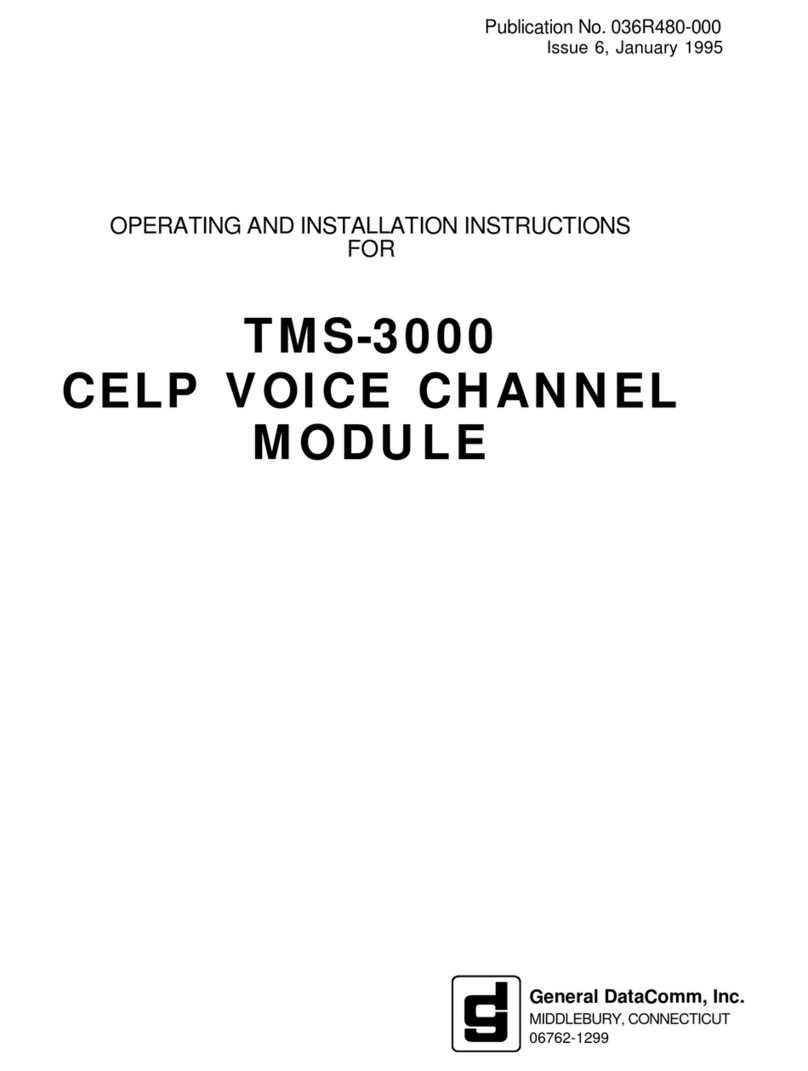
General DataComm
General DataComm TMS-3000 Operating and installation instructions
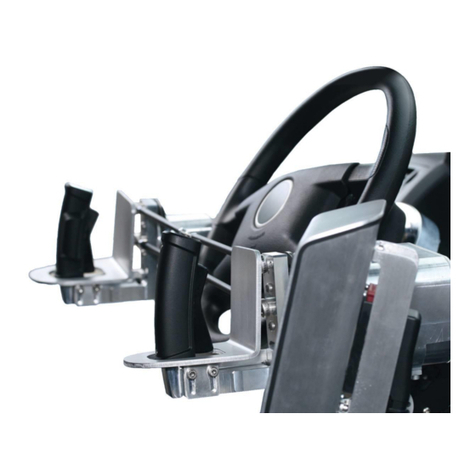
Bozzio
Bozzio Joysteer Generation 2.0 manual

Globalstar
Globalstar ST150 user manual
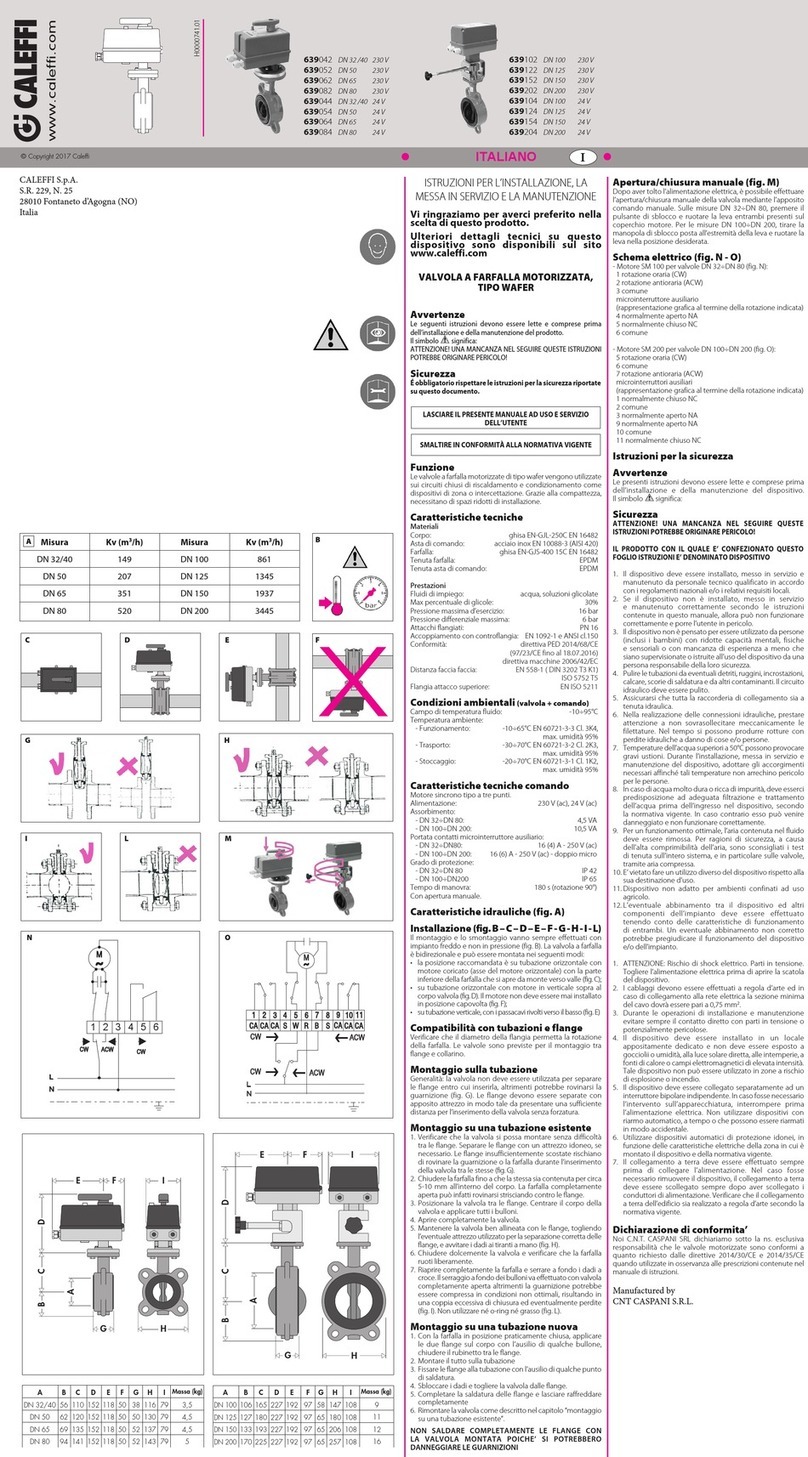
CALEFFI
CALEFFI 639042 INSTRUCTIONS FOR INSTALLATION, COMMISSIONING AND MAINTENANCE

ICP DAS USA
ICP DAS USA ET-7015 quick start guide

Endress+Hauser
Endress+Hauser Cleanfit COA451 operating instructions
